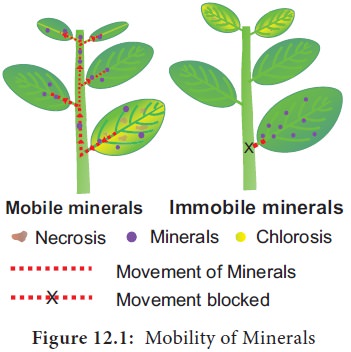Chapter: 11th Botany : Chapter 12 : Mineral Nutrition
Classification of Plants Mineral Nutrition
Classification of minerals
1. Classification of minerals based on their quantity
Essential
elements are classified as Macronutrients,
Micronutrients and Unclassified
minerals based on their requirements.
Essential minerals which are required in higher concentration are called
Macronutrients. Essential minerals which are required in less concentration
called are as Micronutrients.
Historical events in mineral nutrition
Van Helmont (1648) – made first observation
of mineral nutrition, noticed over a period of 5 years soil lost only 56 g in
nourishing a seedling into tree. Increase in organic substance comes from water
alone.
Wood word (1699) – Soil provides mineral
nutrients required for their growth.
De Saussure (1804) – plant growth depends
on nitrogen and other elements absorbed by roots from soil.
Liebig (1840) – gave the “law of minimum” which states that productivity
of soil depends on amount of essential elements present in minimum quantity.
Julius Von Sachs (1860) – Demon-strated growing a plant in a defined nutrient
solution.
William Frederick Goerick (1940) – Gave the
term Hydroponics and com-mercial technique.

Minerals
like Sodium, Silicon, Cobalt and Selenium are not included in the list of
essential nutrients but are required by some plants, these minerals are placed
in the list of unclassified minerals. These minerals play specific roles for
example, Silicon is essential for pest resistance, prevent water lodging and
aids cell wall formation in Equisetaceae (Equisetum),
Cyperaceae and Gramineae (Table 12. 1).
2. Classification of minerals based on mobility
If you observe where the deficiency symptoms appear first, you can notice differences in old and younger leaves. It is mainly due to mobility of minerals. Based on this, they are classified into 1. Actively mobile minerals and 2. Relatively immobile minerals (Figure 12.1).

a. Actively mobile minerals
Nitrogen,
Phosphorus, Potassium, Magnesium, Chlorine, Sodium, Zinc and Molybdenum.
Deficiency
symptoms first appear on old and senescent leaves due to active movement of
minerals to younger leaves.
b. Relatively immobile minerals
Calcium,
Sulphur, Iron, Boron and Copper shows deficiency symptoms first that appear on
young leaves due to the immobile nature of minerals.
3. Classification of minerals based on their functions
a. Structural component minerals: Minerals
like Carbon, Hydrogen, Oxygen and Nitrogen
b.
Enzyme
function: Molybdenum (Mo) is
essential for nitrogenase enzyme during reduction of atmospheric nitrogen into
ammonia. Zinc (Zn) is an important activator for alcohol dehydrogenase and carbonic anhydrase. Magnesium (Mg) is the
activator for RUBP carboxylase-oxygenase and PEP carboxylase.
Nickel
(Ni) is a constituent of urease and hydrogenase.
c. Osmotic
Potential: Potassium (K)
plays a key role in maintaining osmotic potential of the cell. The
absorption of water, movement of stomata and turgidity are due to osmotic
potential.
d. Energy
components: Magnesium (Mg) in
chlorophyll and phosphorous (P) in ATP.
Related Topics